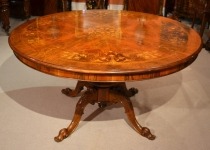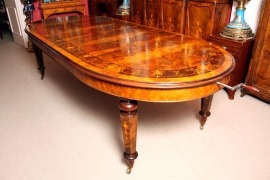Discover the exquisite craftsmanship of marquetry dining tables
Fabulously beautiful and decorative tables which can make a stunning addition to your dining space or conference room.
The origins and features of these fantastically decorative and substantial pieces
 The process of marquetry became very popular in France in the late 16th century. Marquetry uses very thin sheets of contrasting woods, metals or even organic materials such as shells or mother of pearl. These are cut into often very intricate patterns and then glued or cut into the flat surface of pieces of furniture including dining tables. Designs were often floral or inspired by nature, sometimes these were quite stylised and with other makers more naturalistic and narrative. Abstract geometrical shapes were also very popular.
The process of marquetry became very popular in France in the late 16th century. Marquetry uses very thin sheets of contrasting woods, metals or even organic materials such as shells or mother of pearl. These are cut into often very intricate patterns and then glued or cut into the flat surface of pieces of furniture including dining tables. Designs were often floral or inspired by nature, sometimes these were quite stylised and with other makers more naturalistic and narrative. Abstract geometrical shapes were also very popular.
The rise of the wealthy merchant classes and increased demand for Marquetry Dining Tables and other marquetry furniture
With the rapid rise of the wealthy merchant classes during the 17th and 18th centuries in much of Western European the demand for luxurious, ornate domestic furniture increased enormously. Pieces such as very decorative marquetry dining tables took pride of place in the sometimes ostentatious and showy homes of the new bourgeoisie as significant statement pieces and badges of status and wealth.
During these period the designs of André-Charles Boulle, achieved great fame. His beautiful furniture adorned with marquetry patterns is often known as boulle work. The marquetry specialist or ébéniste, would, either drew the design straight on to the base wood table top or stick a paper pattern onto the wood. Thin sheets of marquetry materials were then cut out with a burin or, as the process developed, sometimes a saw was used. The pattern was then assembled and glued onto the carcass.
Boulle created an innovative marquetry method based on contrasting materials, especially ebony and ivory. Two sheets of identical thickness were glued together and the pattern then cut out. When these sheets were taken apart, it was then possible to decorate two panels of the same size with identical patterns in contrasting materials. Marquetry work is delicate and fragile, based on thin materials, so it can be susceptible to splinter or damage. Vulnerable areas, especially the outer edges of the design, were often protected with bronze or other metals, often in an intricate shape, which further added to the decorative beauty of the marquetry dining table.
Towards the later 18th century the range of materials used also became more varied and adventurous; rare tropical woods were especially popular as were metals like silver, bronze, and brass – marquetry work of this period also began to use a wide range of other materials including some of a semiprecious nature.
 Victorian marquetry dining tables
Victorian marquetry dining tables
The Victorian era was characterised by heavy, elaborate, historically based designs and marquetry dining tables became extremely popular. Generally made of mahogany or burr walnut many of these were very substantial pieces with fantastically detailed hand crafted marquetry work. Some were very large and might seat as many as thirty or forty people.
Although these would now only fit the very largest of dining rooms they can make wonderfully impressive tables for conferences and board rooms. Smaller examples sitting six, eight or twelve diners are also available and have been beautifully restored and painstakingly French polished. Many Victorian marquetry dining tables have leaves or extensions and so are flexible as well as fabulous and cannot fail to impress your dinner guests.
Regent Antiques carries a good range of these fabulous tables including some of the really large, flagship pieces.

